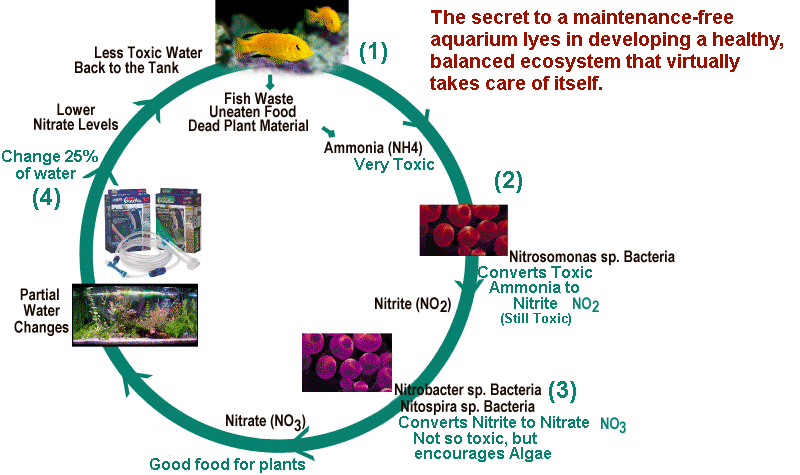Aquarium Manual
Starting Your New Tank

Start Your Aquarium Right
Watching a tranquil aquarium, listening to the trickle of water and visually drinking the color reflections of exotic fish is a busy man's dream. Cleaning, fixing, treating, and generally slaving to keep an aquarium beautiful is a nightmare.
The secret to maintenance-free aquariums is in developing a healthy, balanced ecosystem that virtually takes care of itself.
Aquariums, need a little help to get started. Unlike ponds, it is harder to develop the care-free ecosystem in a small volume of water than in a large one. But that doesn't mean that it is really difficult.
Begin by understanding the cycling process. (See the nitrogen cycle image above). Every part of the cycle feeds some other part of the cycle until the watr is clean.
Always treat new water with toxin-neutralizing products.
Filling the aquarium with water (or even topping it off as it evaporates) introduces dangerous chemicals into the water. Chlorine and Chloramine are toxic to fish and not healthful for plant growth. Some water even contains heavy metals. Always treat new water with toxin-neutralizing products.
Saltwater or marine fish and invertebrates are far more sensitive to water impurities and changes in water conditions. While most tropical tanks do very well with treated tap water, it is a good idea to use de-ionized water or water filtered by reverse osmisis techniques for marine tanks. However, reverse-osmisis water is so pure that it is depleted of essential trace elements and minerals which must be added back to the tank.
Bacteria Eat Fish Waste and Feed the Plants
Now that you have clean, toxin-free water, you need to start some
beneficial bacteria growing in the aquarium and in the filter. Aerobic
(oxygen loving) bacteria
literally eat and digest organic waste products, turning them into
nitrates and fertilizers for plants.
(1) There will be plenty of waste to de-toxify. Fish eliminate in the water and plant material and excess fish food fall to the bottom and decompose. If not properly turned into beneficial products, your aquarium will putrify and die.
(2) Several products contain beneficial (aerobic) bacteria with which to seed the aquarium as well as enzymes to speed the decomposition process. (enzyme and sludge-removing products will be used regularly to enhance the natural cleaning of your aquarium)
Bacteria cling to gravel, rocks, fixtures and to your filter media. They need a large surface area over which the water (carrying its pollutants) can pass. Your filter contains a pre-filter pad that traps large particulates and debris (which you should clean frequently). The filter also contains other materials on which the bacteria grow. Do NOT clean this portion of the filter unless absolutely necessary, and never clean it with chlorinated water. That kills the bacteria you have worked so hard to establish.
Now that you have introduced bacteria, you must give the bacteria something to eat so that they can "live long and prosper". Begin to add small fish and plants.
New Tank Syndrome: Cloudy Water
Many new tanks suffer from "new tank syndrome" - cloudy water. The water becomes cloudy a day or two after start-up because of the death of already-present bacteria. The particulates and bacteria that make your water cloudy can be removed by adding water clarifiers that "clump" the cloudy molecules together and allow them to sink to the bottom or get trapped in the pre-filter. Beneficial bacteria feed on the decomposing molecules of cloudy water and turn them into beneficial products.
Test Early and Frequently
During the first few weeks, before the bacteria has become settled and multiplied, you'll need to test your aquarium's water quality frequently. Too much organic decay and too little bacteria can lead to a high ammonia level which is very toxic to fish. A good all-around water test kit for aquariums will be needed. (do not use a swimming pool or hot tub kit)
(2) "Ammonia Burn" damages fish gills and scales. Stress coats may be added to the water during the "cycling" process (or any time you suspect high ammonia or stress) to help prevent damage to the fish from ammonia build-up. They are a good maintenance treatment any time you are adding water or otherwise adjusting your pond's water quality.
Adjusting the pH of the water is also important. Most tropical aquarium fish thrive in neutral to soft water - water whose pH is at 7. Your test kit will allow you to see the pH. African Cichlids or Marine fish generally like a pH in the 8.3 range. Several products are available for adjusting the pH of the water.
Fish also need electrolytes - especially when they are under stress as when being introduced into a new aquarium. Adding aquarium Salt will give them a boost. (If you have water plants, you may skip the salt as some plants do not do well in salted water.)
(3) If the water begins to turn green, algae may be blooming in your new ecosystem: too much sunlight hitting the tank (even indirectly) or light bulbs with too much UV light, too much fertilizer (from the nitrite turning to nitrate), too few plants. Adjust these factors by doing frequent small water changes, adding more live plants, and consider adding a UV filter to the system. There are also algae-treating additives, which will help in the short run.
(4) As your aquarium settles further into its cycle, it will become more and more stable and care-free. The most important maintenance procedure that should be preformed routinely is small water changes which include gravel vacuuming (to suck any debris or sludge from the gravel), and cleaning the pre-filter.
Use sludge-removers to speed the decomposition, and do water changes of approximaely 25% of the tank water each month.
